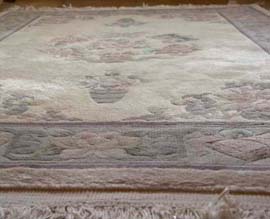
Carpets may contain toxins
Anthesis Consulting Group studied ingredients and circular economy
One reason to pause and reflect is the study of the Anthesis Consulting Group (USA) from the year 2018. The authors examine on 110 pages the effects of chemical additives in carpet manufacturing on the health of the inhabitants and on recycling in the sense of a circular economy. On the basis of intensive research, the authors found that out of 59 toxic ingredients in carpet material, 37 substances are neither prohibited nor restricted. The list of horrors includes plasticisers, flame retardants, heavy metals, biocides, PAHs and various volatile substances (VOCs). Especially children are at risk, according to the study, because they often play on the carpet and take volatile chemicals through the skin or the respiratory tract.
Not all toxic substances are contained in European chemicals legislation
Certain substances are banned, restricted or at least identified in the European Chemicals Act (REACH). The assessment of the substances is subordinate to the national bodies. In a joint Community Rolling Action Plan (CoRAP), the European Chemicals Agency (ECHA) and the EU Member States set each year at the beginning of spring which substances should be assessed by Member State authorities over the next three years. With the publication of the CoRAP, companies subject to registration have the opportunity to enter into dialogue with the assessment authorities and to address the concerns, e.g. through complementary studies or measures to minimize environmental emissions. The Anthesis Group found that twelve of the substances mentioned in its report are not included in the CLP (Classification, Labeling and Packaging) list, including aromatic amines that are considered to be potentially carcinogenic or mutagenic. Ten substances are classified as potentially questionable; however, no further official measures are planned. Especially curious: lead and DINP plasticizers are banned in children’s toys, but approved as carpet ingredients.
Different quality of the eco-label
The Anthesis report also examines the quality of environmental labels. Good ratings received the “Blue Angel”. The German label prohibits 51 of 59 substances or restricts them. This review comes closest to “The Nordic Swan”, an environmental label of the Nordic countries based in Stockholm. For example, it limits the use of isocyanates in carpets, while it restricts only the halogenated ones in the flame retardants. Anthesis classifies unfavorably the GUT seal introduced by industry. This label prohibits only 13 of the 59 risky chemicals. By contrast, none of the labels examined restricts the group of aromatic amines identified in the Anthesis report as degradation products of azo dyes and hazardous chemicals.
Use the power of consumers
Consumers have the opportunity to support and accelerate regulatory action. Demand for eco-friendly and healthier carpets would put more pressure on retailers and manufacturers to create greener products. Anyone who pays attention to the above-mentioned eco-labels “Blue Angel” or “Nordic Swan” when buying floor coverings has already avoided the biggest mistakes. Products without seals should have a full declaration of the ingredients. Substances of very high concern can be evaluated using the SVHC list (Substances of Very High Concern). However, this rather tedious process requires a dose of willpower from the consumer.
Pollutants can be measured in house dust
Certain ingredients in carpets can cause acute disease symptoms. Thus biocides are suspected of irritating the eyes or the skin. Silver can also cause skin irritation. Heavy metals also accumulate in the liver and kidneys in the long term. At least in the first few weeks after the carpet has been applied, volatile substances are effective. Styrene, butadiene or toluene are some of the most toxic representatives. For acute health problems or for precaution, building biologists recommend the analysis of house dust. In contrast to the room air measurement, this form of investigation is cheaper and can be mastered without special equipment.
